Sheila M. Martin-Corbin
Lesson 1
Pre-assessment on the Cardio-vascular System
The goal of this formative assessment is to assess students’ knowledge of the anatomy of the heart and physiology of the cardio-vascular system and help to guide my instruction.
Students will choose the best answer that completes each statement below.
1. Which system transports oxygen and nutrients to body cells?
-
a. respiratory system
-
b. excretory system
-
c. circulatory system
-
d. digestive system
2. The two upper heart chambers are called
-
a. ventricles
-
b. atria
-
c. aorta
-
d. valves
3. Oxygen-rich blood from the lungs enters the
-
a. left atrium
-
b. right atrium
-
c. left ventricle
-
d. right ventricle
4. The heart chamber that works hardest is the
-
a. right atrium
-
b. right ventricle
-
c. left atrium
-
d. left ventricle
5. The blood vessels that carry blood back to the heart are the
-
a. arteries
-
b. veins
-
c. capillaries
-
d. ventricles
6. When the ventricles contract, the bicuspid valve prevents blood from flowing from
-
a. the right ventricle to the right atrium
-
b. the left ventricle to the left atrium
-
c. the left atrium to the right atrium
-
d. the right atrium to the left atrium
7. Which one of the following blood vessels carries oxygenated blood?
-
a. superior vena cava
-
b. inferior vena cava
-
c. pulmonary artery
-
d. pulmonary vein
8. Pulmonary circulation involves movement of blood between heart and the
-
a. kidneys
-
b. lungs
-
c. brain
-
d. liver
9. The carotid artery is located in the
-
a. armpit
-
b. groin
-
c. neck
-
d. leg
10. The smallest and most numerous blood vessels in the body are the
-
a. veins
-
b. arteries
-
c. capillaries
-
d. pulmonary veins
Closure
At the end of the discussion review with students that arteries carry deoxygenated blood and veins carry oxygenated blood. Arteries are blood vessels that carry blood away from the heart and veins carry blood toward the heart.
Homework
-
1 Ask students to draw an analogy between the cardiovascular system and a mail
-
delivery system .
-
-
2. Open-ended Question: Sometimes babies are born with a hole in the septum
-
between the two atria. Based on what you know about blood flow through the
-
heart, explain why this condition would be harmful to the baby.
Lesson 2
This lesson is a simple activity on breathing and exercise. Students will have the opportunity to locate each others’ pulse and compare breathing rates before and after exercise. Students will discuss other factors besides exercise that might have an effect on one’s breathing rate.
Objectives
-
1. Students will be able to locate each others’ pulse.
-
2. Students will be able to count each pulse rate accurately.
-
3. Students will be able to relate pulse rate to heartbeat.
-
4. Students will be able to explain why exercise can affect one’s breathing rate.
Materials
-
Clock or stopwatch
-
Paper
-
Pen or pencil
Go over the homework questions with students. Make reference to the open-ended question and why it is not a good thing to lose so much blood. What does the blood transport that is readily needed by body cells?
Procedure
-
1. Demonstrate to students how to locate a pulse by gently placing the first and middle fingers on the inside of your wrist. Allow students to practice doing this.
-
2. Tell students to relax, sit quietly and breathe normally for 1 minute.
-
3. Have each partner locate the other partner’s pulse and count the number of breaths he or she takes in 1 minute. This will be the normal breathing rate and students will record this number in a data table.
-
4. Have students run or jog for 30 seconds. Then sit down and have each partner count the number of breaths taken in 1 minute by the other student. Record the breathing rate in the data table.
-
5. Allow time for the student’s breathing rate to return to normal. Have students perform same exercise for 1 minute. Again sit down and have each partner count the number of breaths taken in one minute.
-
6. Have students graph their results.
OBSERVATIONS
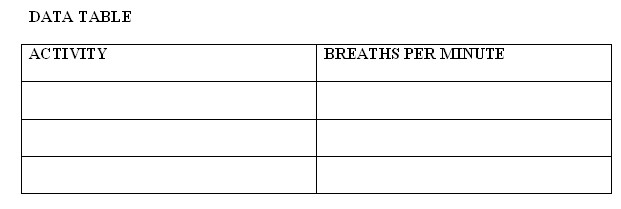
Analysis and Conclusions
Have students answer the following questions below to show their understanding of the laboratory activity and the relationship with different activities and breathing rate.
1. Did exercise affect your breathing rate? What evidence is there to support your answer?
__________________________________________________________________
_________________________________________________________________
2. If yes, how did it affect your breathing rate?
_________________________________________________________________
3. Why do you think exercise does or do not affect your breathing rate?
__________________________________________________________________
4. Can you think of other factors besides exercise that might influence your normal
breathing rate?
_________________________________________________________________ .
5. Did you notice any other way in which your breathing changed with exercise? If
so, give a possible reason for this change in your breathing.
__________________________________________________________________
__________________________________________________________________
__________________________________________________________________
6. What happens to the blood supply to the muscles during exercise (jogging)? How is
this related to the change in pulse rate?
_________________________________________________________________
Closure
Have students discuss and share their findings with the whole class.
Homework
Ask students to take the pulse rate of their parents/guardians and siblings and graph the data. Students will describe their findings and discuss any observable correlation between age and heart rate.
EXTENSION ACTIVITY
Students will keep a log of their heart rate taken in the morning and at night for a week.
They will graph this data and analyze their findings.
Below is a graph of hypothetical data comparing breathing rate at rest to breathing rate after exercise.
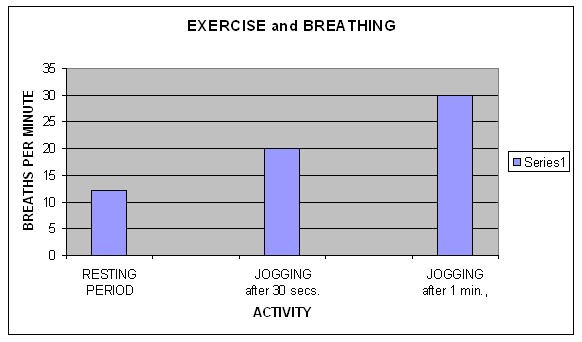
Below are samples of hypothetical data to show the effect of Exercise on Heart Rate and Pulse Rate.
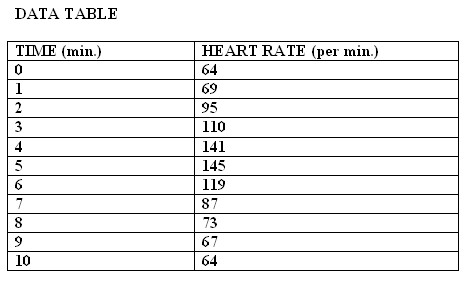
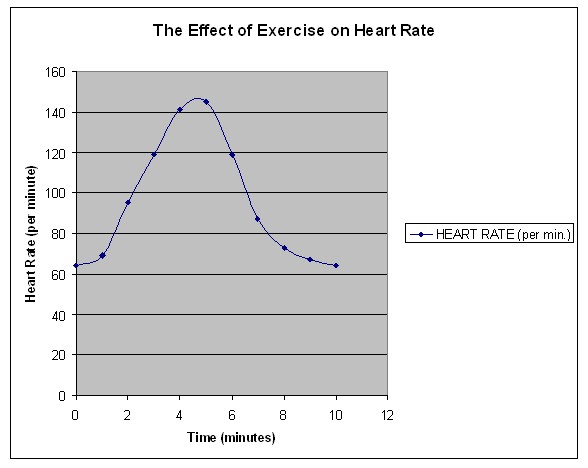
SAMPLE GRAPH
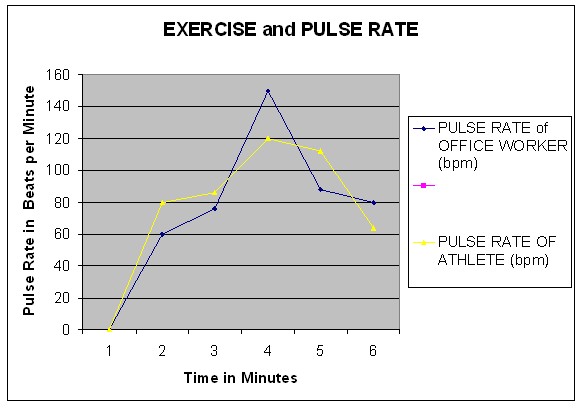
Hypothetical Results:
The graphs above show that the heart rate and pulse rate didn’t increase a huge amount for the first minute but then increased very steeply for most of the rest of the exercise. However, during the final minute the heart rate doesn’t increase very much. This happened because the supply of oxygen to the muscles decreased, and a lot of energy will be used up as the exercise took place. Anaerobic respiration occurs resulting in the formation of lactic acid and an increase of carbon dioxide levels which contributes to the heart rate rising. The body has to pay back that oxygen back when it is resting. When this is accomplished the body’s heart rate returns to the normal resting pulse rate.
Lesson 3
This is an inquiry-based CAPT like lab. investigating heart rate in humans during various activities. Students will work in small groups of two or three to design a laboratory procedure to investigate how holding one’s breath and/or jump rope will affect his or her pulse rate and heart rate.
Objectives
-
Students will work in teams of two and
-
Students will be able to write a problem statement for the laboratory activity.
-
Students will be able to identify the dependent variable and the independent variable.
-
Students will formulate a hypothesis based on prior knowledge.
-
Students will be able to write a step by step procedure for the laboratory activity so that another person can replicate it.
-
Students will be able to analyze the lab and make informed decisions about their health.
Materials
-
Stop watch
-
Lab. partner
-
Pen/pencil
-
Lined paper
-
Graph paper
-
Jump rope
Follow-up Questions
1
.
How was heart rate affected when you held your breath? Explain.
____________________________________________________________________
____________________________________________________________________
2. Explain the change in heart rate between someone standing versus jumping rope. Why
does this change occur?
_____________________________________________________________________
Lesson 4
This lesson is designed to motivate more students with diverse abilities to actively participate in doing research and present their findings to the class in creative ways which are non-threatening to their learning styles.
Purpose
Students will identify and research approaches made by the U.S. government to reduce the number of deaths caused by heart attack.
Objectives
-
Students will be able to describe and give examples of cardiovascular disease
-
Students will be able to explain causes for cardiovascular diseases
-
Students will make informed decisions to help prevent heart attacks.
Suggested Methods:
-
Banning cigarette smoking in public areas
-
Banning of the use of Trans fat in restaurants
-
Changes in school cafeteria menus
-
Advance technology for surgical procedures
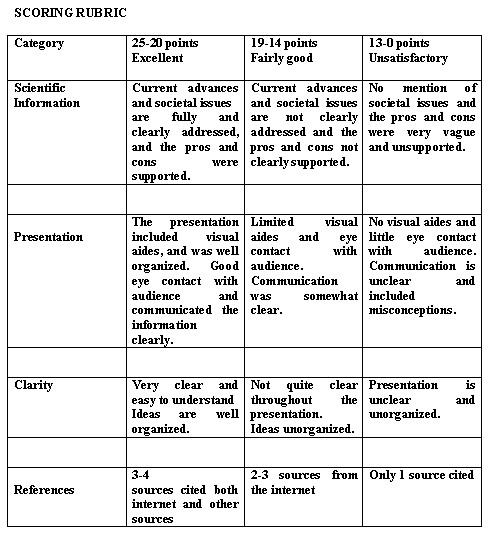
Lesson 5
Heart Dissection
Dissection of a sheep heart is valuable because it is similar in size and structure to the human heart. Also, dissection allows students to view and identify structures intact much better than observed in models and diagrams.
Objective:
-
Students will be able to locate and identify the structures of the heart.
-
Students will be able to describe the importance of the structures of the heart.
Materials:
-
Dissecting tray, a preserved sheep heart, dissecting instruments, gloves
Procedure:
Rinse the sheep heart in cold water and place in dissecting tray.
Observe the texture of the pericardium and find its point of attachment to the heart.
Examine the external surface of the heart and note the accumulation of adipose tissue.
Carefully scrape away some of the fat with a scalpel to expose the coronary blood vessels.
Identify the base and apex of the heart.
Identify the right and left sides of the heart.
Identify the two auricles, earlike flaps of tissue projecting from the chambers of the atria.
Observe the ventricles.
-
To identify the left ventricle, compress the ventricular chambers exposing coronary blood vessels. The side that feels thicker and more solid is the left ventricle. The right ventricle is much thinner and feels somewhat flabby when compressed.
-
The difference reflects the greater demand placed on the left ventricle, which must pump blood through the much longer systemic circulation.
-
Hold the heart in its anatomical position with the anterior surface uppermost. In this position the left ventricle composes the entire apex and the left side of the heart.
-
Identify the pulmonary trunk and the aorta leaving the superior aspect of the heart. The thickened-walled aorta, which branches almost immediately, is located just beneath the pulmonary trunk.
-
Cut through the wall of the aorta until you see the aortic valve. Identify the two openings into the coronary arteries just above the valve.
-
Insert a probe into one of these holes to see if you can follow the course of a coronary artery across the heart
-
Turn the heart to view its posterior surface.
-
Identify the superior and inferior vena cava entering the right atrium. )
-
Compare the approximate diameter of superior vena cava with that of the aorta.
-
Find out which one is larger, and which one has thicker walls
-
Explain why you suppose these differences exist.
-
Properly dispose of the dissected heart and clean the dissecting tray and tools.
Homework
Students will make a labeled drawing of the sheep heart showing the external and internal structures.
Students will describe the pathway of blood flow throughout the human heart.
Extended Activity --Aerobic Exercise
Objectives:
-
1. Students will be able to identify the ways in which regular and the type of exercise contributes to the improvement and maintenance of good health.
-
2. Students will learn personal responsibility for their health and be able to identify those types of activities which will positively affect their health.
Aerobic Exercise is a kind of exercise for building endurance and a healthy heart. To do aerobic exercise, your heart should be beating at a rate that falls within a certain range. For example, the range for some people is 140 to 170 heartbeats per minute. This means that the heart should be beating at least 140 times each minute but not more than 170. The minimum and maximum number depends upon a person’s age.
During exercise, more blood is needed to carry oxygen to the muscles, so blood pressure rises to meet increased demand. The heart pumps faster and pushes out more blood with each beat.
To calculate the minimum and maximum number for teenagers:
-
1. Subtract the person’s age from 220 and multiply the answer by 0.7 (Minimum #)
-
2. Subtract the person’s age from 220 and multiply by 0.85
When doing aerobic exercise, the range of heartbeats defined by the minimum and maximum numbers is called the “target heart rate”.
Calculate your target heart rate for doing aerobic exercise.
___________________________________________________________________
Explain clearly how to measure your pulse rate.
_______________________________________________________________________
_______________________________________________________________________
_______________________________________________________________________
______________________________________________________________________ .
Measure your pulse rate while sitting
________________________________________________________________________
______________________________________________________________________ .
Measure your pulse rate after doing jumping jacks or jumping rope for 3 minutes.
________________________________________________________________________
Was the exercise you perform an aerobic exercise? Explain.
________________________________________________________________________
_______________________________________________________________________